|
每一年,我们都向成千上万的游戏从业者和Gamasutra读者们询问他们的上年度收入情况和大量相关问题。接受我们的调查的人有工作数年的开发者,也有刚入行的新人,调查的项目包括基本工资、福利、补贴和其他工作信息。如果你想入行游戏业,看看我们的调查结果,也许你能得到一些启示。 有趣的是,初入行的游戏从业者的平均工资呈全面增长,这与行业稳定但缓慢的发展趋势形成鲜明对比。无论你是打算从测试员还是营销员做起,收入的增长都是相当可观的;当然,某类工作的报酬会比其他的高很多。 这年,整个游戏行业的平均收入是81192美元,与2012年的公布的80817美元相比,水平较为接近。但从数字上看不出来的是,今年的游戏业发展比过去几年更稳定得多。2011年,只有13%的调查对象被解雇,而2010年的是14%,2009年的是19%,这些被解雇的的人在游戏业中找到新工作的比率与2011年的58%相比,增长了6%。 更多的薪水和稳定的发展让游戏从业者对职业生涯和整个行业更加乐观。大部分从业者——65%的人表示对自己的未来职业道路感到“满意”或“非常满意”(游戏邦注:这比2010年增长了4%),34%的人相信游戏业会比去年提供更多工作岗位(增长5%),54%的人认为游戏从业者的机遇比以前更多了(增长了7%)。 尽管如此,变化仍然巨大。独立开发在2011年尤其向前迈了一大步:个体独立开发者的主要报酬平均是23549美元,比2010年的11379美元多了1倍多。而独立开发团队的成员平均收入是38239美元,比2010年的26780美元增长了11459美元。如果你想闯进这个行业,你的收益会比以前更多。以下是各类从业者的薪资的比对详情。 程序员 平均收入,从业3年或以下:66116美元 行业对程序员的需求量大,即使是入门级别的;从业3年的程序员的平均收入比其他的类工作人员的要高,除了商务人员。他们的收入比去年的平均数55426美元实际增长了10700美元。考虑到参与我们调查的程序员比去年多,可以看出,游戏业雇佣到有才能的程序员的速度还是不够快。 但加拿大的程序员收入增长并没有这么显著:平均所有级别的程序员的收入为74970美元,与去年相比只增长了500美元。欧洲程序员平均收入是46801美元,与2010年相比下降了1400美元(游戏邦注:下文中所指的平均收入都是指所有级别的从业人员的收入平均值)。 虽然女性从业者的比例比以前下降了(从2010年的6.9%下降到2011年的2.9%),但根据调查结果,她们的平均收入水平增长了大约8800美元,与男性同行的7000美元相比,增幅更大。然而,工资差距仍然存在,并且差距明显;女性程序员平均收入(83333美元)大约比男性程序员(93263美元)低了1万美元。  programmer salaries(from gamecareerguide)
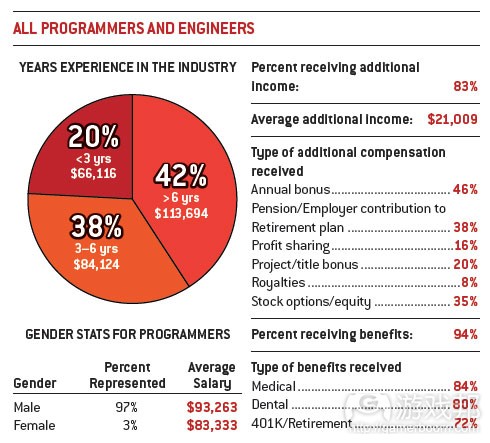 programmer & engineer(from gamecareerguide)
美术人员和动画师 平均收入,从业3年或以下:49481美元 入行时间低于3年的美术人员和动画师可以发现,自己的收入增长显著,比去年相比增长了约3700美元,但与程序员、制作人和商务人员相比,他们的平均水平仍然处于收入频谱的低端。另外,想要成为游戏美术人员和动画师的人注意了:游戏行业对艺术家来说是很臭名昭著的行业,因为艺术家往往被要求快速掌握技术专长,鞠躬尽瘁直到才华消耗殆尽,所以选择进入这个行业的人要谨慎了。 加拿大美术人员和动画师的平均收入(所有级别平均后)是66651美元,增长了大约3300美元。但是,欧洲美术人员就没这么走运了。他们的平均收入为35887美元,比2010年减少了大约5000美元。 女性占受调查美术人员总数的13%,增长了2%。她们的平均收入水平(52875美元)实际减少了大约6800美元。然而,从事美术和动画的男性平均收入为79124美元,与2010年相比增加了大约6200美元。 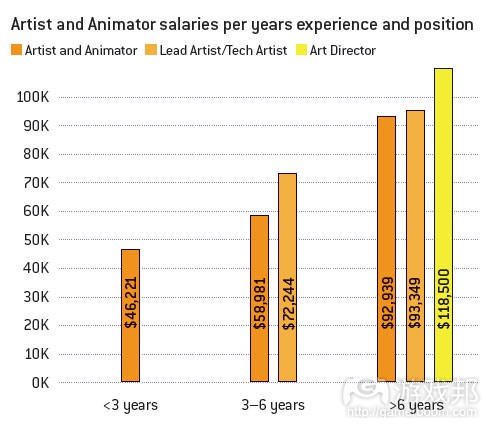 artist and animator(from gamecareerguide)
 all artists & animators(from gamecareerguide)
游戏设计师 平均收入,从业3年或以下:50375美元 初级游戏设计师和编剧的平均收入比上一年增长了4100美元,基本上处于行业收入频谱的中段。这类工作并不容易得到,因为竞争者多,而岗位少。另外,如果你没有从事游戏行业的经验,也没有自己制作过游戏,你大概不太可能竞争到设计职位。 加拿大游戏设计师平均各级别后的收入是60240美元,与2010年相比增长了约1950美元。而欧洲游戏设计师平均收入是38281美元,缩水约3000美元。 接受调查的设计师中,女性比例是10.9%,2010年则是7%;她们的平均收入是67000美元,增长2850美元。男性设计师的平均收入是74180美元,比2010年增长了3500美元。  game designer salaries(from gamecareerguide)
 game designers(from gamecareergudie)
制作人 平均收入,从业3年或以下:55893美元 初级制作人在2011年的平均收入大约比2010年增加了3600美元, 以55893美元的平均总收入处于游戏业收入频谱的高端。这与2011年的平均总收入形成反差:相比于2010年,减少了2850美元,尽管仍然比其他部门的收入高,除程序和商务以外。 2011年,加拿大游戏制作人的平均收入是71500美元,比2010年减少了1000美元。欧洲制作人的收入增加了3500美元 ,到达56346美元。有趣的是,欧洲制作人的收入比该地区的其他所有游戏开发部门的都高。 2011年,在制作人行列,女性的比列相对较高(16%),但比2010年下降了1%。有意思的是,大部分男性制作人的平均收入减少了,从90744美元下降至87119美元;而女性制作人的平均收入实际上略有增长,从77870美元升至78354美元。  producer salaries(from gamecareergudie)
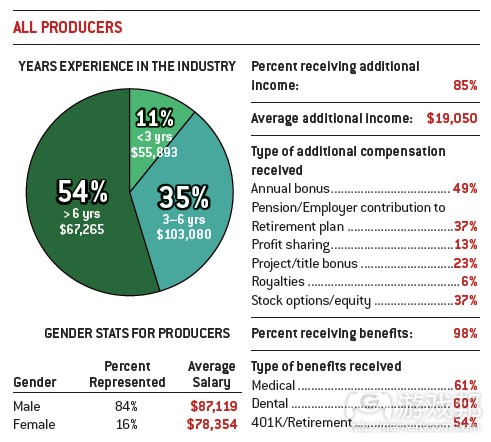 all producers(from gamecareerguide)
音频人员 平均收入,从业3年或以下:32500美元 游戏行业的音频人员不太好采样,因为工作岗位不多,大多数工作是以外包的形式完成的,而不是付薪水。全职、拿工资的音频工作通常只向熟练的开发者开放,而这类人的收入水平是比较高的,而入门级的从业者极少,并且工资水平普遍不高(顺便一提,这使我们很难收集到可靠的数据。参与调查的音频人员总数仅4人,根据他们的数据,初级音频人员的平均收入是32500美元。) 外包音频人员在2010年多创收3200美元。拿工资的音频人员与其他部门的员工相比,获得补贴的可能性最低,不过,他们的平均收入为9875美元,确实比2010年增长了2200美元。 加拿大音频人员在2011年的平均收入是67955美元,下降了600美元。不幸的是,我们没有收集到足够的欧洲音频人员的回复,所以不能得出任何有意义的结论。 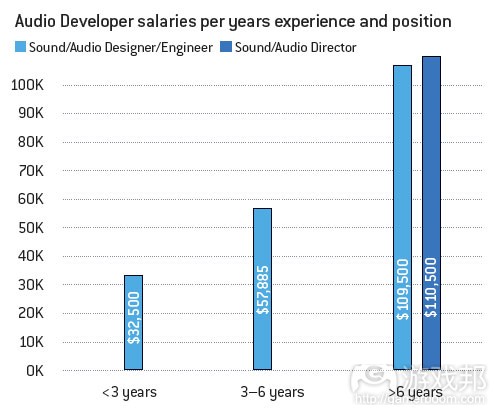 audio developer salaries(from gamecareerguide)
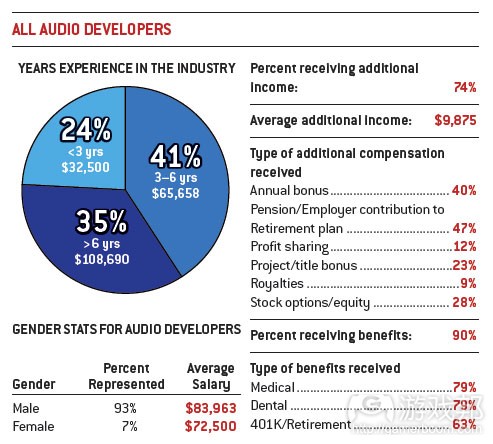 all audio developers(from gamecareerguide)
QA测试员 平均收入,从业3年或以下:37000美元 QA测试是游戏业中收入最低的工作,特别是刚入行的人员。所幸的是,他们的平均收入比去年增加了800美元。如果你没有任何职业技能如编程或美术,但又想进入游戏行业,QA测试可能是最容易着手的工作。但工作室给QA职位提供的晋升机会并不像其他职位那么多,所以有才能的QA主管往往改行成为设计师或制作人。 大多数QA测试人员是以合约形式工作的,有工资的职位大多数是给QA主管的。QA测试的合约工作者的平均收入是27065美元,比2010年增长了大约4150美元。 有趣的是,从业时间少于3年的测试员的平均收入增长了大约6200美元,而具有3到6年经验的QA主管收入增加了3700美元。加拿大QA人员的平均收入是43125美元,与2010年相比,增长了5100美元。欧洲QA人员的平均收入是32500美元,比2010年减少了约6750美元。  QA tester(from gamecareerguide)
 All QA testers(from gamecareerguide)
商务和法务人员 平均收入,从业3年或以下:71818美元 这里的“商务和法务人员”包括首席执行官和执行经理、社区经理、营销、法务、人力资源、IT、内容采集和授权、总务员工。商务方面,资历浅的人平均收入增长了14000美元,从57778升至71818美元。 商务人员的平均收入是行业中最高的(10万2160美元),得到的非工资性收入也是最多的(24874美元)。然而,两个数字与2010的相比,实际上都下降了,分别减少了3300和4000美元。 在游戏业的商务人员中,女性的比例相对较高,达到17.6%,比今年整个行业的女性从业者平均比例高7.6%,比2010年高3.6%。  business & legal people(from gamecareerguide)
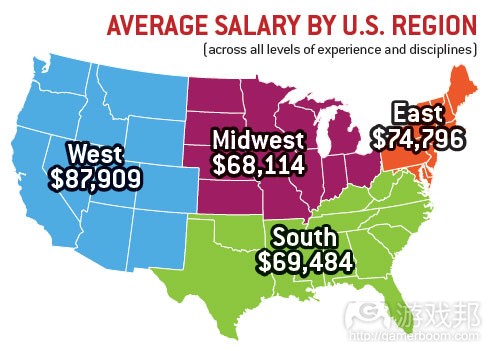 average salary by US region(from gamecareerguide)
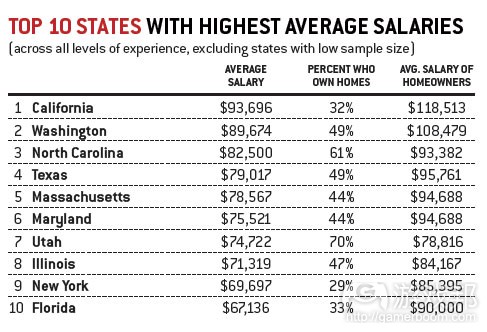 top 10 states with highest average salaries(from gamecareerguide)
 average salary by US region by descipline(from gamecareerguide)
 average salary for homeowners(from gamecareerguide)
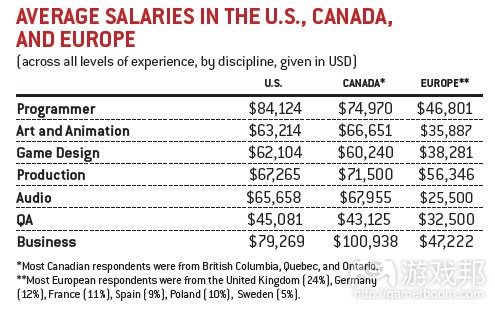 average salaries in three regions(from gamecareerguide)
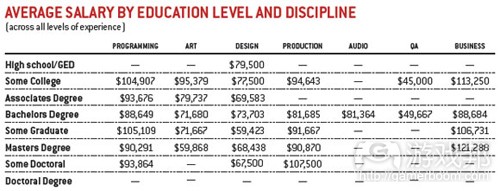 average salary by education level(from gamecareerguide)
格局 游戏业的工作岗位呈稍微稳定的局势。在3100位调查对象中,13%在2011年被解雇,与2010年的14%和2009年的19%相比,变化不大。 在这些被解雇的人当中,58%在游戏业中找到新工作,19%从事合约或咨询工作,10%创办自己的公司,13%从事独立游戏开发,13%没有找到新的游戏开发工作(注意,本次调查的问题,允许调查对象作出多种回答)。 为数不少的调查对象表示再次被同一家公司雇用,既有成为外包合作者,也有改变职称的受薪员工(但职责相同)。 少数解雇人员选择了自己创业、加入独立工作室或从事外包工作。这可能是社交和手机游戏业呈缓慢泡沫化的信号,这一行业近年来流失了大量资金。 独立游戏开发者报告 这是第三次收集独立游戏开发业的数据,我们调查了个体独立开发者、独立团队和个体承包工作者。在这三类群体中,独立承包工作者的收入水平最高,而其他两类在2011年收入都比2010有了显著增长。  contractors by job funtion(from gamecareerguide)
独立承包工作者平均收入达到56282美元(比2010年增加了800美元),个体独立开发者平均收入是23549美元(比2010年增加了11379美元),独立开发团队的成员收入平均是38239美元(比2010年增加了26780美元)。 随着独立游戏行业不断成熟、资源实力逐渐增强,从事这类工作的收入看似多少也得到巩固。与2010年相比,更多独立开发者选择了在团队中工作,而不是一个人单干。 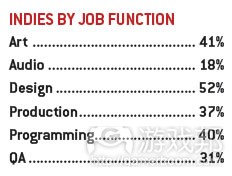 indies by job function(from gamecareerguide)
独立游戏的收益在2011年也增加了一点。出售游戏的收入少于500美元的独立开发者比例从2010年的55%减少到2011年的48%。16%的独立开发者靠出售游戏获利超过6万美元,而在2010年时,这个比例仅8%。 同时,非游戏收益来源(非游戏DLC/额外内容、赞助或广告收入和奖金/补助)仍然很难得到——79%没有得到任何额外收入(比2010年下降了2%)。没有非游戏收益来源的开发者通常挣得也不多,44%收入低于1000美元,比2010年的35%有所增长。通常,擅长设计游戏的开发者通过非游戏收益来源能够得到可观的收入,无论是在2010年还是2011年,具有这类收入来源的开发者中,40%的收入能超过5000美元。 工作职能 虽然我们调查了独立游戏开发者和合约工作者在游戏业中的工作职能,但我们有区别地组织了这份调查,以指出这两类群体的差别。在小独立团队中开发游戏意味着大多数开发者没有完全固定的职能——通常戴着不同的头衔,所以要求独立游戏开发者只报告一个职能的情况是不完全准确的。另一方面,大多数合约游戏开发者的情况有所不同。同样地,独立游戏业的调查表格应该读作“至少从事这项工作的独立开发者的比例是多少”,而不是“专门从事这项工作的独立开发者的比例是多少”。 越来越多独立开发者的工作涉及设计(59%,上升了7%)、编程(53%,上升了13%、QA(43%,上升了12%)和制作(47%,上升了10%),不过从事美术和音频的比例稍有下降(分别是40%和17%,比2010年各下降了1%)。考虑到参与调查的独立开发者的人数总地来说是相等的,这意味着独立开发者承担的职能比以前更多了——优秀的独立团队成员是可以编程、测试、设计、绘画和管理生产进度的人。 调查方法 在游戏从业者收入调查的第11个年头,本次调查的执行时间是2012年2月,调查时间范围是2011年1月1日至2011年12月31日。协助调查的是Audience Insights。我们向《Game Developer》的订阅读者、游戏开发者大会的参与者和Gamasutra.com网站的会员发送邮件,邀请他们参与本次调查。 我们收集到来自世界各地的游戏从业者的4132份回复,但并不是所有参与本次调查的人都提供了足够全面的信息,因此没有全部纳入最终报告中。我们也排除了年收入少于1万美元的学生和教育工作者。 少数人的年收入超过20万2500美元,这类人也被排除了,因为他们过高的数值会使最终平均数偏差过大。我们也排除了缺少关键群体和分类数量不足的记录。 这份调查的地域范围主要在美国,但也分别结合了从加拿大和欧洲收集的数据。在可用的样本中,美国的受薪员工人数是1742人,加拿大是403人,欧洲是339人;来自世界各地的、提供了可用信息的独立开发者和独立合约工作者人数是524人。我们的收入调查中出现的样本可以反映美国的游戏从业者的收入情况,但包含加减2.4%的误差范围,可信度为95%。加拿大的受薪员工的误差范围是加减5%,欧洲的是5.4%。 言论 为了听取从业者对游戏行业发出的心声,我们在调查报告的最后留下空间给他们作评论。以下是一些比较值得注意的回应。 负面看法 “工作和生活的平衡是非常糟的。从事游戏并不是件光荣的事。游戏业对待工程师就像垃圾,特别是与可以在游戏之外的行业轻易得到的待遇相比。” “希望游戏是有趣的、有创意的、独特的,这种渴望正在消退,因为对金钱的无止境需求。制作在社交游戏市场中常见的、令人讨厌的派生游戏是最挣钱的。游戏业正在走电影业的老路,不断地将原作重制和制作前传,毫无创新可言。除了那些太相信自己的独立开发者以外。” “我越是在这个行业中工作,我越觉得与玩家脱节。沉默的少数比以前更加愤怒。” “有时我真想离开这个行业。那个念头已经非常强烈了。因为,女性在这个行业显然是很难立足的。幸好我最近加入了一家公司,我的性别不再成为解雇我的借口,这令我感到振奋。另外,许多公司关门大吉了,许多公司正在招聘。总是能找到工作的。但我们必须停止‘一旦游戏发行就通过解雇员工来节省公司开支’的做法。我们必须向毕业生敞开大门,不能总是要求对方有经验,这样新人就没有机会学习了。” “我仍然为游戏业表现出的性别和种族歧视感到惊讶,为改变这种观点的困难感到诧异。虽然游戏业整体上有所改观,但我常常得向同事解释为什么某些内容——无论他们感到多滑稽,可能会冒犯某些群体。有时候办公室仍然存在‘男孩俱乐部’的气氛,许多女性被置于受歧视和不公平的地位。” “在英国,这是可怕的一年。几乎没有任何新的设计岗位,好多工作室都倒闭了。” “音频设计师在游戏行业往往被当作一次性资源,无论是在游戏业内部还是外部,我们的机会都极少,因为音频设计这一行受严重误解和低估了。我们还有一线希望,但我们必须团结起来,用响当当的事实喊出我们的心声,为我们的工作正名。在优秀的游戏中,音频发挥了重大作用,如《Bastion》和《传送门2》,确实很激励我们。” “美术的外包工作使游戏美术成为不太被美术新人看好的职位。为什么要在美术学校砸那么多钱、花那么多时间磨练技术,只是为了到工作室做从外包商那里接来的低贱的清扫工作?许多有才华的美术人员基本不再创作了,只是执行平庸的清扫任务。” 正面看法 “我认为,在不远的几年内,就制作什么游戏和谁制作游戏而言,集体融资和自主发行的出现将会带来重大转变。独立游戏工作室再次控制了必要的工具和资金,将重新掌舵回游戏开发业的发展,就像他们在‘80年代和90年代早期’。” “我们正处于重大转折点。数字推广模式和手机游戏的爆炸式发展,开辟了小工作室和快速开发的新时代。用2-3年时间开发AAA游戏的时代即将终结。” “我们正处于变革时代,不只是商业模式和推广平台,还有道德观念。我对未来很乐观——越来越多人在玩游戏,当经济萧条结束时,我们会看到游戏业的各方面都开始盈利。” “游戏业正处于创意革命的边缘,SDK和自主发行越来越便利,越来越少的创意总监来自因循守旧的发行者,而是,越来越多的来自眼界开阔、敢于实验创新的开发者。” “能够适应社交和手机游戏崛起的开发者做得很好,可惜世界的总体经济形势不佳。手机和社交游戏令人兴奋,因为它允许开发者专注于简单、严密而精致的游戏玩法。因此,我认为近来的趋势一定程度上回到了‘游戏的黄金时代’。” 不要畏惧社交游戏 “关于游戏设计和如何吸引广泛的受众,还有很多要学习的。想想从未玩游戏的人到成为社交游戏玩家要花的平均时间,比让他们玩传统的游戏更短。如果说某些早期的社交游戏公司是不择手段的,不要让这种想法阻碍你从社交游戏中学习有意义的东西,而要让这种经验帮助你提升设计。”(本文为游戏邦/gamerboom.com编译,拒绝任何不保留版权的转载,如需转载请联系:游戏邦) Game Developer Salary Survey 2012 by GameCareerGuide.com staff Every year, we ask thousands of Game Developer and Gamasutra readers to tell us how much money they made last year, along with a slew of related questions. We get everyone from established developers to newbies to tell us their base salaries, benefits, additional compensation, and other work information so we can show you what to expect if you decide to pursue a career in the game industry. Interestingly, the average salaries for the entry-level crowd have increased across the board, which stands in contrast to the industry wide trend of small-but-steady growth. Whether you’re looking to start a career in quality assurance or business, you’ll see salaries rising rather impressively-though some disciplines are paid much more than others. This year, we learned that the average salary across the entire game industry is $81,192, hovering near the same level as 2010′s $80,817 reported average. What that number doesn’t tell you is that the industry was significantly more stable this year than it has been in the past several. Only 13 percent of respondents were laid off in 2011, compared to 14 percent in 2010 and 19 percent in 2009, and those that received layoffs were 6 percent more likely to find a new job elsewhere in the game industry (58 percent, up from 52 percent in 2011). Having a little more money and stability in turn made developers feel more optimistic about their careers as well as the industry as a whole. A majority of developers — 65 percent — said they felt “satisfied” or “extremely satisfied” with their potential career path (up 4 percent from 2010), 34 percent believed that there were more jobs in the industry than the year before (up 5 percent), and 54 percent felt that there were more opportunities for game developers than before (up 7 percent). Nevertheless, there’s still plenty of change going on. Independent devs in particular made a big step in 2011: Individual indie developers reported an average $23,549 in primary compensation, more than double 2010′s $11,379, while members of independent developer teams made an average of $38,239, up $11,459 from 2010′s $26,780. If you are looking to break into the industry, more avenues are available for you than ever before. Here’s to living in the clouds. Programmers Average Salary, 3 Years or Less: $66,116 Programmers are in high demand, even at the entry-level; the average salary for programmers in their first three years is higher than that of all other disciplines except business, and it’s actually up $10,700 over last year’s average of $55,426. Considering we had more programmers respond to the survey than we did last year, it seems that the industry simply can’t hire talented programmers fast enough. But Canadian developers didn’t see the same boom-their $74,970 (USD) average across all skill levels was only up about $500. European programmers reported an average of $46,801 (USD), down about $1,400 from 2010. While women were underrepresented in the workforce even more than usual (2.9 percent in 2011, down from 4 percent in 2010), they did report an average increase of about $8,800, compared with their male counterparts’ $7,000 increase. However, the wage gap is still alive and well; the average female programmer’s salary ($83,333) is nearly $10,000 lower than the average male programmer’s ($93,263). Artists and Animators Average Salary, 3 Years or Less: $49,481 Artists and animators with less than three years of experience saw a respectable increase of about $3,700 over the previous year, but their average still places them in the lower end of the spectrum compared to programmers, producers, and businesspeople. Also, would-be game artists and animators should take note: The game industry is kind of a notorious grind on artists, who are often expected to quickly develop a technical specialty and worked hard until they burn out, so be careful when choosing where and how to enter the industry. Artists and animators in Canada received an average salary (across all skill levels) of $66,651 (USD), up about $3,300. Artists in Europe didn’t fare so well, however. Their $35,887 (USD) average salary fell about $5,000 from 2010. Women comprised 13 percent of our surveyed artist pool, up 2 percent, though their average salary across all skills levels ($52,875) actually decreased about $6,800. Men in art and animation, on the other hand, made $79,124 on average, which is up about $6,200 from 2010. Game Designers Average Salary, 3 Years or Less: $50,375 The average salary for entry-level game designers and writers is $4,100 higher than the previous year’s, and it stands roughly in the middle of the industry’s salary spectrum. This discipline isn’t always the easiest one to get into, though, meaning there can be a lot of competition for relatively few jobs. Also, if you have no prior game industry experience, you probably won’t be able to land a design gig without having at least made a few of your own games.
Canadian game designers across all skill levels averaged $60,240 (USD), up about $1,950 from 2010, while European game designers averaged $38,281 (USD), which is down about $3,000. Female designers made up 10.9 percent of our designer responses, compared to 7 percent from 2010, and their average salary across all skill levels of $67,000 is up $2,850 from 2010. Male designers, on the other hand, made an average of $74,180 in
2011-up $3,500 from 2010. Producers Average Salary, 3 Years or Less: $55,893 Entry-level producers received an average of about $3,600 more in 2011 than they did in 2010, and their overall average of $55,893 is on the higher end for the game industry. This stands in contrast to the overall average for producers in 2011; they saw a $2,850 salary cut compared to 2010, though they still draw a higher salary than all other departments except programming and business. Canadian game producers across all skill levels averaged $71,500 in 2011, down $1,000 from 2010. European producers’ salaries increased $3,500 to $56,346. Interestingly, producers in Europe are paid more than any other department of game development in the region. Women are well represented in the producer ranks this year (16 percent), down 1 percent from 2010. Interestingly, men absorbed most of the salary drop; their average salary across all skill levels dropped from $90,744 to $87,119, while women producers’ salaries actually rose slightly from $77,870 to $78,354. Audio Professionals Average Salary, 3 Years or Less: $32,500 Audio jobs in the game industry are a tricky thing to monitor because there aren’t nearly as many jobs for audio professionals, and most of those jobs are offered as contract gigs instead of salaried work. Full-time, salaried audio jobs are often only open to accomplished developers at the higher end of the experience (and salary) spectrum, while entry-level gigs are scarce and not particularly well paid. (This, by the way, makes it harder to collect reliable data for our survey-the $32,500 average for entry-level audio workers comes from a grand total of four respondents.) Audio professionals working in contract roles also made an extra $3,200 in 2010. Salaried audio workers were the least likely to receive extra compensation for their work out of any discipline, though the $9,875 they received is up $2,200 from 2010. Canada-based audio professionals received an average salary across all skill levels of $67,955 in 2011, down $600 from 2010. Unfortunately, we didn’t collect enough responses from European audio workers to make any significant conclusions. QA Test Average Salary, 3 Years or Less: $37,000 Quality-assurance professionals are the lowest-paid people in the game industry, especially the entry-level hires. On the bright side, they did manage to make an extra $800, on average, over the previous year. If you’re trying to break into the game industry without any trade skills like programming or art, you will probably find QA the easiest place to start out. But not many studios offer a QA career track that is as developed as the other disciplines, so talented QA leads often end up moving over to design or production instead. Most QA employees are hired on a contract basis, with salaried positions mostly given to QA leads. QA contractors across all skill levels made an average of $27,065 in 2011, up about $4,150 from 2010. Interestingly, average salaries for testers with less than three years of experience rose about $6,200 from 2010, and QA leads with 3 years to 6 years of experience saw a $3,700 boost. Canadian QA professionals across all skill levels made an average of $43,125 (USD), up $5,100 from 2010. European QA workers made $32,500 (USD), which was about $6,750 less from 2010. Business and Legal People Average Salary, 3 Years or Less: $71,818 The “Business and Legal People” category includes chief executives and executive managers, community managers, marketing, legal, human resources, IT, content acquisition and licensing, and general administration staff. Younger people on the business side made an average of $71,818 in 2011, $14,000 up from $57,778 in 2010. Business professionals received the highest average salary (across all skill levels) in the industry ($102,160), as well as the most additional nonsalary income ($24,874). However, both those numbers are actually down from 2010 by $3,300 and $4,000, respectively. Women were relatively well represented in the business side of the game industry, reaching 17.6 percent in 2011, which is 7.6 percent higher than average across the entire industry this year, and 3.6 percent higher than in 2010. Average Salary by Region Layoffs Jobs in the game industry appear to be getting slightly more stable. Of 3,100 respondents, 13 percent had been laid off in 2011, compared to 14 percent in 2010 and 19 percent in 2009. From those people who were laid off, 58 percent found new employment in the games industry, 19 percent went into contracting or consulting, 10 percent founded a new company, 13 percent went into independent games development, and 13 percent haven’t found new game development work. (Note that for this survey question, multiple responses were allowed.)
A significant amount of respondents reported being laid off and rehired by the same company, either as a contractor, or as a salaried employee with a different job title (but the same responsibilities). Fewer laid-off developers opted to start their business, join an independent studio, or go into contract work this year. This could be a sign of a slowing bubble in the social and mobile sectors, which were giving away massive amounts of cash in recent years. The Indie Report This is the third year we’ve collected data for our indie report, where we survey individual independent developers, independent teams, and individual contractors for their perspective on the industry. Out of those three groups, independent contractors made the most, though both individual indies and members of indie teams pulled in significantly more in 2011 than they did in 2010. Independent contractors averaged $56,282 in 2011 (up $800 from 2010), individual independent developers averaged $23,549 (up from $11,379 in 2010), and members of independent developer teams averaged $38,239 (up from $26,780 in 2010). As the indie game community continues to mature and grow financially, it also seems to be consolidating somewhat. Compared to 2010, more independent developers are working in teams rather than going solo. Indie games made a bit more money in 2011, too. 48% of independent developers made less than $500 from the sale of their game, down from 55% in 2010. 16% of independent developers made over $60,000 from the sale of their game in 2011, compared to 8% in 2010. Meanwhile, nongame revenue streams (nongame DLC/additional content, sponsorship or ad opportunities, and awards/grants), remained relatively hard to obtain-79% didn’t receive any additional income whatsoever (down 2% from 2010). The developers that did cash in through non-game revenue streams generally didn’t make a whole lot, either; 44% made under $1,000, compared to 35% from 2010. In general, it appears that the developers who are good at designing games to take advantage of non-game revenue streams are able to pull in a decent amount; in both 2010 and 2011, 40% of developers with these sources of income were able to make over $5,000. Job Functions While we survey both indie game developers and contractors for their job function in the game industry, we structure the survey differently to adjust for the difference between the two sectors. Developing a game in a small independent team means most developers don’t have completely specialized roles — usually people are wearing multiple hats, so asking an independent games developer to only report one discipline wouldn’t be completely accurate. On the other hand, that’s not the case for most contract game developers. As such, the indie chart should be read as “what percentage of independent developers do at least this job function,” rather than “how many independent developers do this job exclusively.” More and more indie developers are finding themselves in roles involving design (59%, up 7%), programming (53%, up 13%), QA (43%, up 12%), and production (47%, up 10%), while art and audio have declined slightly (40% and 17%, each down 1% from 2010). Considering our number of independent developer responses overall were roughly equal, this means independent developers are wearing more hats than ever before-a good indie team member is someone who can code, test, design, produce art, and manage a production schedule. Methodology Now in its eleventh year, the Game Developer Salary Survey was conducted in February 2012 for the fiscal year January 1, 2011 through December 31, 2011 with the assistance of Audience Insights. Email invitations were sent to Game Developer subscribers, Game Developers Conference attendees, and Gamasutra.com members asking them to participate in the survey. We gathered 4,132 responses from developers worldwide but not all who participated in the survey provided enough compensation information to be included in the final report. We also excluded salaries of less than $10,000 and the salaries of students and educators. The small number of reported salaries greater than $202,500 were excluded to prevent their high numbers from unnaturally skewing the averages. We also excluded records that were missing key demographic and classification numbers. The survey primarily includes U.S. compensation but consolidated figures from Canada and Europe were included separately. The usable sample reflected among salaried employees in the U.S. was 1,742, for Canada 403, and for Europe 339; and 524 for indies and independent contractors who provided compensation information worldwide. The sample represented in our salary survey can be projected to the U.S. game developer community with a margin of error of plus or minus 2.4% at a 95% confidence level. The margin of error for salaried employees in Canada is plus or minus 5%, and is 5.4% for Europe. Literals In order to hear what developers are saying about the industry right now, we allowed space at the end of our survey for direct comments. Here are some of the more notable responses. The Bad “The attitude toward work life balance is absolutely terrible. It is not an honor to work in games. Engineers are treated like garbage, especially when compared to the treatment they can easily get outside of games.” “The desire for games to be fun, creative, and unique is slowly being diminished by the never-ending need for money, money which is best acquired by making derivative boring titles often seen in the social games market. The game industry is going the way of the movie industry with constant remakes and prequels and no new innovation besides independents who often give themselves too much credit.” “The longer I work in the industry, the less I can relate to gamers. The vocal minority is more annoying than ever.” “This is an industry I’ve at times wanted to leave. I’ve often come very close to it. Because, plain and simple, it’s not easy being a woman in this industry. Thankfully I’ve recently joined a company where my gender isn’t used against me as an argument to dismiss me, and it’s been a really empowering experience. Also, a lot of companies are closing, many are hiring. There’s always a job open somewhere. But we need to stop the firing of employees once a game has shipped as a viable ‘saving the company money’ measure, and we need to find ways to welcome students within our ranks better, as opposed to always ask for only experienced personnel, thus not giving newcomers a chance to learn.” “I’m still surprised by how much sexism/racism the industry exhibits, and by how difficult it is to change perspectives on it. While the industry as a whole is slowly improving, I frequently find myself trying to explain to coworkers why certain content — however hilarious they find it — might offend certain groups of people. There still seems to be a “boys’ club” atmosphere in the office sometimes and many women are put in the unenviable and unfair position of political correctness enforcer.”
“It’s been a terrible year in the U.K. There have been hardly any new design positions, and so many studios have closed.” “Audio designers in the game industry are often treated as a disposable resource, and the opportunities for us, both inside and outside the game industry, are incredibly scarce, as sound is very much misunderstood and undervalued as a craft. There are bright glimmers, but we have to really band together, speak up, and make a lot of noise about examples of great sound design to help continue to validate our work. Great games where audio plays a prominent role like Bastion and Portal 2 really help us to move forward.” “The outsourcing of art jobs has made this a less than desirable position for starting artists. Why spend thousands of dollars on an art degree, and countless hours perfecting your skills, only to come into a studio and do lackey clean up on work received from the outsourcers? A lot of talented artists don’t even really create art anymore, just mundane clean-up tasks.” The Good “I think the advent of crowd-funding and self publishing is going to see a huge shift in the coming years in terms of what games get made and who makes them. Indie game studios once again possess the tools and funding necessary to retake the game development industry much like they did in the ’80s and early 1990′s.”
“We’re at a big turning point. The digital distribution model, along with the explosion of mobile gaming, is ushering in a new age of smaller studios and quicker development cycles. The age of triple A, 2-3 year games is coming to an end.” We’re in a time of great change, not only in business models and distribution platforms, but also in ethics. I’m optimistic for the future — more people than ever are playing games and when this recession is over, we’re going to see some incredible revenue across all aspects of the industry.” “It seems that the industry is on the precipice of a creative revolution as SDKs and self-publishing options are getting more accessible, creative direction will come less from the publisher, who relies more on proven methods, and more from wild-eyed developers who would rather experiment than replicate.” “Developers that have been able to adapt to the rise of social and mobile gaming have done well despite an overall economic decline in the world. Mobile and social gaming is exciting because it allows a developer to focus on simple, tight, and polished gameplay. In that regard I feel the recent trend is somewhat of a return to the ‘golden age of games’.” Don’t Fear Social Games “There is a lot to learn about game design and how to appeal to a wide audience. Think about the average time until someone who has never played a game before starts having fun in your game-social games do this better than most traditional games. This is an incredible and exciting thing. If some of the early companies in social games were unscrupulous, don’t let this keep you from learning exciting lessons from social gaming and let this improve your own designs.” (source:gamecareerguide)
|